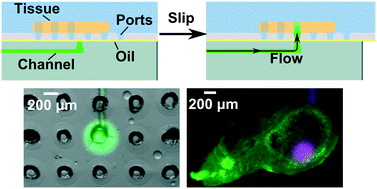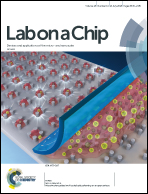User-defined local stimulation of live tissue through a movable microfluidic port†
Abstract
Many in vivo tissue responses begin locally, yet most in vitro stimuli are delivered globally. Microfluidics has a unique ability to provide focal stimulation to tissue samples with precise control over fluid location, flow rate, and composition. However, previous devices utilizing fixed ports beneath the tissue required manual alignment of the tissue over the ports, increasing the risk of mechanical damage. Here we present a novel microfluidic device that allows the user to define the location of fluid delivery to a living tissue slice without manipulating the tissue itself. The device utilized a two-component SlipChip design to create a mobile port beneath the tissue slice. A culture chamber perforated by an array of ports housed a tissue slice and was separated by a layer of fluorocarbon oil from a single delivery port, fed by a microfluidic channel in the movable layer below. We derived and validated a physical model, based on interfacial tension and flow resistance, to predict the conditions under which fluid delivery occurred without leakage into the gap between layers. Aqueous solution was delivered reproducibly to samples of tissue and gel, and the width of the delivery region was controlled primarily by convection. Tissue slice viability was not affected by stimulation on the device. As a proof-of-principle, we showed that live slices of lymph node tissue could be sequentially targeted for precise stimulation. In the future this device may serve as a platform to study the effects of fluid flow in tissues and to perform local drug screening.

- This article is part of the themed collection: Lab on a Chip Emerging Investigators


 Please wait while we load your content...
Please wait while we load your content...